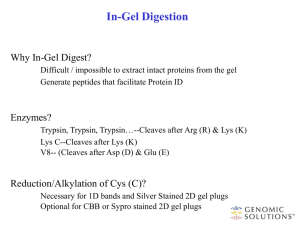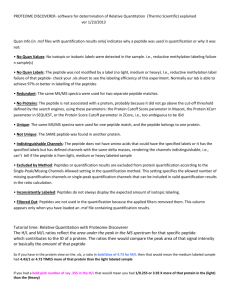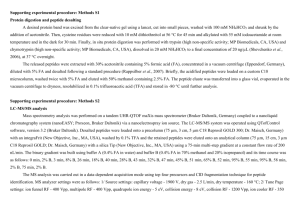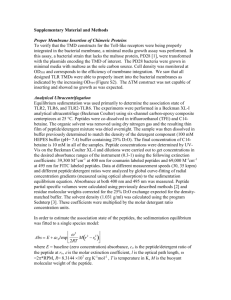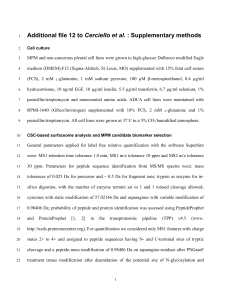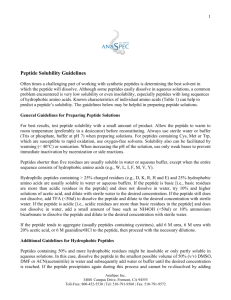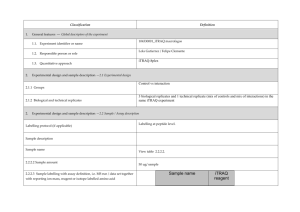emi12438-sup-0003-Appendixs2
advertisement
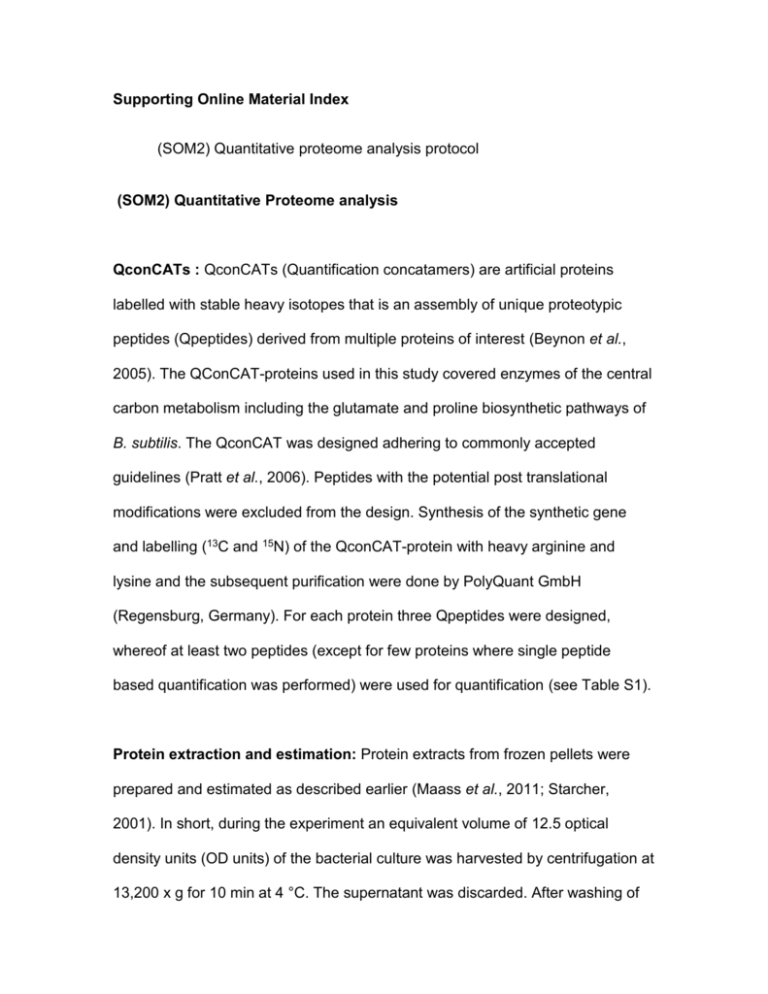
Supporting Online Material Index (SOM2) Quantitative proteome analysis protocol (SOM2) Quantitative Proteome analysis QconCATs : QconCATs (Quantification concatamers) are artificial proteins labelled with stable heavy isotopes that is an assembly of unique proteotypic peptides (Qpeptides) derived from multiple proteins of interest (Beynon et al., 2005). The QConCAT-proteins used in this study covered enzymes of the central carbon metabolism including the glutamate and proline biosynthetic pathways of B. subtilis. The QconCAT was designed adhering to commonly accepted guidelines (Pratt et al., 2006). Peptides with the potential post translational modifications were excluded from the design. Synthesis of the synthetic gene and labelling (13C and 15N) of the QconCAT-protein with heavy arginine and lysine and the subsequent purification were done by PolyQuant GmbH (Regensburg, Germany). For each protein three Qpeptides were designed, whereof at least two peptides (except for few proteins where single peptide based quantification was performed) were used for quantification (see Table S1). Protein extraction and estimation: Protein extracts from frozen pellets were prepared and estimated as described earlier (Maass et al., 2011; Starcher, 2001). In short, during the experiment an equivalent volume of 12.5 optical density units (OD units) of the bacterial culture was harvested by centrifugation at 13,200 x g for 10 min at 4 °C. The supernatant was discarded. After washing of the pellets with 2 mL of TE-buffer (20 mM Tris, 10 mM EDTA, pH 8) the pellets were stored at -80 °C. Frozen pellets were resuspended in 500 µL of ice cold TEbuffer and added to a prefilled 2 mL vial (Sarstedt) with 500 µL amount of unwashed glass beads (160µm, Sigma Life sciences, St. Louis, USA). Cell disruption was performed by ribolyzing (FastPrep, Thermo Scientific, Waltham, USA) for 30 s at 6.5 m s-1 speed and then on ice for 5 min, this was repeated for two more times (repetition ensured the disruption efficiency to be 99 - 99.9 % complete) and centrifuged at 13,000 x g (10 min, 4°C). Resultant supernatant was transferred to a new 1.5 mL microcentrifuge tube (carryover of glass beads is avoided) and centrifuged at 13,000 x g (30 min, 4°C), this process was repeated once again to remove remains of glass beads and cell debris. Protein concentration of extracts was determined using a ninhydrin-based assay (Starcher, 2001). Briefly, 20 μL of crude protein extract was mixed with 20 μL 12 N HCl and incubated for 24 h at 100 °C. 400 µL of a 200-fold dilution of the hydrolyzed protein extract was added to 600 μL of freshly prepared ninhydrinreagent. After 10 min incubation at 100 °C the extinction was measured at 575 nm. For every batch of samples a calibration curve using BSA (bovine serum albumin) ranging from 0.25 μg μL-1 to 10 μg μL-1 was prepared. Purification and Digestion: In order to purify the protein extracts by in gel digestion, 15 µg of protein lysate and a defined amount of QconCat was applied to a NuPAGE® Bis-Tris Gels 4-12 % (Life Technologies Corporation, Carlsbad. USA). Separation, staining and destaining was carried according to the manufacture guidelines except for the run time. The run was stopped exactly after 5 min which allows the sample to be separated for 1 cm. Each lane was sliced into three pieces which were processed independently (see Figure S1). The gel pieces were washed twice with 200 μL of 20 mM ammonium bicarbonate in 50 % (v/v) acetonitrile (ACN) for 30 min at 37 °C. Thereafter the gel pieces were dehydrated by two times washing with 200 μL of ACN for 15 min. Trypsin solution (20 ng μL-1 trypsin in 20 mM ammonium bicarbonate) was added until the gel pieces stopped swelling. Digestion was allowed to proceed for 16–18 h at 37 °C. The peptides were extracted from the gel pieces with 40 μL of 0.1 % (v/v) acetic acid by incubation in an ultrasonic bath for 30 min, followed by a second extraction with 40 μL of 50 % ACN in 0.05 % acetic acid. The peptide containing supernatants of each band were collected and pooled for each lane; excess liquid was removed by lyophilisation. The resulting peptide mixtures were resuspended in 100 µL of buffer A (0.1 % acetic acid, 2 % ACN) and purified using C18-ZipTip columns (Millipore, Bedford, USA). 300 ng of the purified peptide mixture was used for subsequent MS analysis. LC-MS/MS analysis: Peptide separation was carried out using an Acelaim PepMap 100 column (C18, 3 mm, 100 Å, 15 cm bed length, Dionex) and applying a binary gradient from 0% to 40% buffer B (100 % acetonitrile (v/v), 0.1 % acetic acid (v/v)) in 70 min and to 100 % B in additional 15 min at a flow rate of 300 nL min-1. LC-MS experiments were performed on a triple quadrupole mass spectrometer (TSQ Vantage, Thermo Scientific, Waltham, USA) operated in nano-electrospray mode. For ionization 1,800 V of spray voltage and 250 °C capillary temperature were used. The resolution for both quadrupoles i.e., for Q1 and Q3 was set to 0.7 Da (FWHM). The collision gas pressure of Q2 was set at 1.5 mTorr. Three transitions (product ions) per peptide (precursor) with highly ranked intensities were chosen for targeted analysis. Collision energy was optimized for each of the product ions belonging to the corresponding peptide using Skyline (MacCoss Lab, Washington, USA) (MacLean et al., 2010a; MacLean et al., 2010b). By combining the optimized collision energies and the recorded retention time for each target peptide a scheduled method was developed to measure all the peptides of interest in a single MS/MS analysis. TSQ Vantage was operated in SRM (single reaction monitoring) mode and data acquisition was done in scheduled SRM manner. Data analysis: Two LC-MS/MS measurements were performed for each sample and the raw files were analysed with the software Skyline 1.0. Ratios of peak areas for endogenous light peptides to heavy Qpeptides were exported from Skyline. Based on the known amount of the spiked Qpeptides the endogenous light peptide concentrations were calculated. Peptides that exhibit missed cleavage and bad chromatographic properties were excluded from quantification of that corresponding protein.


